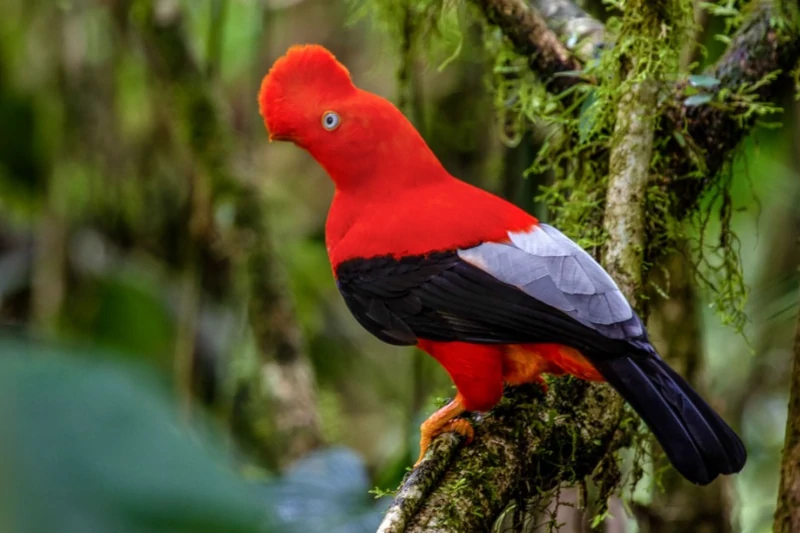Despite its popularity among tourists, the wildlife of Machu Picchu is not as well-known as its cultural heritage. In this article, we will explore the diversity of animal life that inhabits the Machu Picchu Sanctuary and its significance in the ecosystem. From the majestic Andean condor to the elusive spectacled bear, let’s delve into the fascinating world of the wildlife of Machu Picchu.
Machu Picchu, the ancient Inca citadel nestled in the Andes Mountains of Peru, is not only a cultural wonder, but also a wildlife sanctuary. This historical site, listed as a UNESCO World Heritage Site, provides a unique habitat for a wide range of fauna, some of which are endemic to the region.
Llama
One of the most iconic animals of Machu Picchu is the llama. These friendly, wooly creatures are indigenous to the Andes and have played a vital role in Inca culture for centuries. You will likely see llamas wandering around the site, grazing on the grass and posing for photos with tourists.
The llama is a domesticated animal that played a vital role in the Inca Empire. This ancient empire existed in the Andean region of South America from the 13th to the 16th century. The Incas relied on llamas for transportation, wool, meat, and even as sacrificial offerings in religious ceremonies.
Llamas are well-suited for the high altitudes of the Andes Mountains. These animales were used as pack animals to carry goods such as food, textiles, and precious metals. The wool of the llama was used to make clothing and textiles, which were highly valued by the Inca people. Llama meat was also an important source of protein in the Inca diet. Also, their dung was used as fuel for fires.
In addition to their practical uses, llamas also held religious significance in the Inca culture. They were often sacrificed in ceremonies to honor the gods and ensure a good harvest.

Vizcacha
The vizcacha is a small rodent that can be found in the Historic Sanctuary of Machu Picchu. This animal is known for its distinctive appearance. It has long ears and a bushy tail that it uses to balance while hopping around rocky terrain.
Vizcachas are herbivores and feed mainly on grasses and other plants. They are social creatures and can be found in groups of up to 10 individuals. They are most active at dawn and dusk when they venture out of their burrows to forage for food.
Also, the vizcacha is an important part of the ecosystem in the Historic Sanctuary of Machu Picchu. Additionally, it is considered a symbol of the Andes Mountains. Visitors to the sanctuary may be lucky enough to spot these unique animals in the rocky terrain and grassy areas. However, it is important to remember to observe them from a distance and not disturb their natural habitat.

Andean fox
The Andean fox is another animal of Machu Picchu. This fox is well-adapted to the high altitudes of the Andes Mountains, and is known for its thick fur. The Andean fox is a carnivore and feeds mainly on small animals such as rodents, rabbits, and birds. They are also known to scavenge on carrion and occasionally eat fruits and other plant material.
In Andean legends and folklore, the Andean fox is often portrayed as a mischievous and highly intelligent creature. Many stories feature the fox using its wit and cunning to outsmart other animals and humans. In other legends the Andean fox is depicted as a hero who uses its intelligence to help humans.
Throughout Andean folklore, the Andean fox is revered for its intelligence and resourcefulness. It is often seen as a symbol of cunning and adaptability. Its ability to survive in harsh mountain environments is seen as a testament to its strength and resilience.

Andean cock-of-the-rock
The Andean cock-of-the-rock is another animal of Machu Picchu. It is a brightly colored bird that can be found in the Andean region of South America. The males are known for their striking orange-red feathers and distinctive fan-shaped crest on their head, which they use to attract mates during breeding season.
Andean cock-of-the-rocks are social birds and can be found in groups of up to 20 individuals. They are primarily fruit-eaters, and their diet includes a variety of fruits, berries, and insects.
Today, the Andean cock-of-the-rock is a protected species, and efforts are being made to conserve its habitat and prevent poaching. Visitors to the Andean region may be lucky enough to spot these beautiful birds in the wild, but it is important to remember to observe them from a distance and not disturb their natural habitat.

Andean condor
The Andean condor is another unique animal of Machu Picchu. It is a large bird of prey that is native to the Andean region of South America. Also, it is one of the largest flying birds in the world, with a wingspan that can reach up to 10 feet (3 meters). It can be seen flying among the high peaks of the Andes, such as the Salkantay Mountain.
Condors are scavengers and feed mainly on carrion, using their keen eyesight to spot dead animals from high in the sky. They are an important part of the Andean ecosystem, helping to keep it clean by consuming the carcasses of dead animals.
In Andean culture, the condor is a symbol of power and strength. It is often depicted in art and folklore as a sacred bird with the ability to fly between the worlds of the living and the dead. In some legends, the condor is portrayed as a messenger of the gods, carrying messages between the heavens and the earth.

Spectacled bear
The Spectacled bear, also known as the Andean bear, is a bear species that is native to South America, particularly the Andean region. It is named after the distinctive markings around its eyes, which resemble eyeglasses.
Spectacled bears are primarily herbivorous, feeding on a variety of fruits, berries, and plant material. They are also known to occasionally eat small animals and insects.
In Andean culture, the Spectacled bear is often revered as a powerful and mystical animal. In some stories, it is portrayed having supernatural abilities, such as the power to control the weather or heal sickness.
Despite its cultural significance, the Spectacled bear is facing a number of threats in the wild, including habitat loss and hunting. Conservation efforts are underway to protect the species and its habitat, and visitors to the Andean region may be able to see these fascinating bears in the wild, but it is important to remember to observe them from a distance and not disturb their natural habitat.























